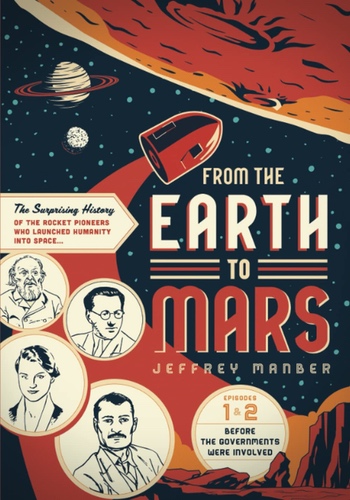 |
Review: From the Earth to Mars
by Jeff Foust
Monday, June 19, 2023
From the Earth to Mars: The Surprising History of the Rocket Pioneers Who Launched Humanity Into Space
by Jeffrey Manber
Multiverse Media, 2023
paperback, 106 pp., illus.
ISBN 978-1-960119-67-4
US$23.95
The Space Age is conventionally defined as starting with the launch of Sputnik in 1957. There was, of course, an extensive history leading up to that launch, with some preferring to define the era as starting with the first successful suborbital V-2 launch almost exactly 15 years earlier. But even before that there had been decades of development and dreaming about rockets for space travel.
That prehistorical Space Age is the subject of From the Earth to Mars, a new book by Jeffrey Manber, a longtime space entrepreneur currently at Voyager Space. The book, the first in a series, examines efforts in Germany and the Soviet Union in the 1920s to lay the groundwork for a spaceflight industry and, as the subtitle suggests, correct misperceptions about that era.
| For much of the 1920s, interest in spaceflight was outside of government, by individuals and organizations, with some expectation it might develop privately, like aviation. |
The book consists of two sections, or episodes, the first examining growing interest in spaceflight in Germany in the 1920s and the second in the Soviet Union in the same decade. In both countries there were people working on the scientific and technical underpinnings of spaceflight, as well as those who were popularizing it to broader audiences, even as liquid-fueled rockets themselves were in their infancy. That led to events like a Russian space travel exhibition attended by more than 10,000 people over three months in 1927 and the famous German movie Die Frau Im Mond that, among other things, invented the countdown.
There are many familiar figures in the book, like Hermann Oberth, Willy Ley, and Konstantin Tsiolkovsky. However, the book also highlights some people who, while not well-known today, played key roles in that era as well. One of them is Thea von Harbou, wife of Fritz Lang, director of Die Frau Im Mond. She wrote a novel of the same name upon which the film was based; that novel was based on what she learned about spaceflight from Oberth and Ley. She was also, Manber notes, a member of the Nazi party, and he speculates she wrote the book and helped create the movie to raise awareness about the military potential of rocketry.
Another such individual was Robert Esnault-Pelterie, a French aviation pioneer who turned his attention to spaceflight. He is credited for popularizing the term “astronautics” and sponsoring a prize for advancements in that field. (Oberth was the first winner.) He also predicted that the costs of spaceflight would be so high that only governments could bankroll it.
Manber treats that development with some regret. For much of the 1920s, interest in spaceflight was outside of government, by individuals and organizations, with some expectation it might develop privately, like aviation. (The lunar expedition in Die Frau Im Mond was a private, not government, mission.) When governments in Germany and elsewhere started supporting, and then taking over, rocket development, it becomes almost an “original sin” for spaceflight in his view, taking it off a more commercial path. That’s illustrated in one passage where Manber recalls a brief conversation with Oberth in 1985 in Houston; Manber asks about contemporary commercial space developments and Oberth responded that he had predicted it decades ago, only to have governments intervene.
That exchange is literally illustrated: the book includes some scenes in graphic novel format. It is an interesting hybrid approach of conventional text, illustrations and graphic novel scenes that works well, keeping the book flowing well.
Besides describing the roles of German and Russian spaceflight pioneers, the book is also a corrective for some American views of spaceflight. The United States did not share the enthusiasm of Germany or the Soviet Union about space in the 1920s, despite the work of Robert Goddard. That work, while closely followed overseas, was at times ridiculed in the US, particularly in an infamous New York Times editorial. While the Times issued a correction in 1969 at the time of Apollo 11, Manber argues it contributed to an incorrect belief that there is a direct line from Goddard to Apollo. A more direct path, of course, comes from those efforts in Europe, particularly Germany. That, he promises, will be explored in future episodes of his book.
No comments:
Post a Comment